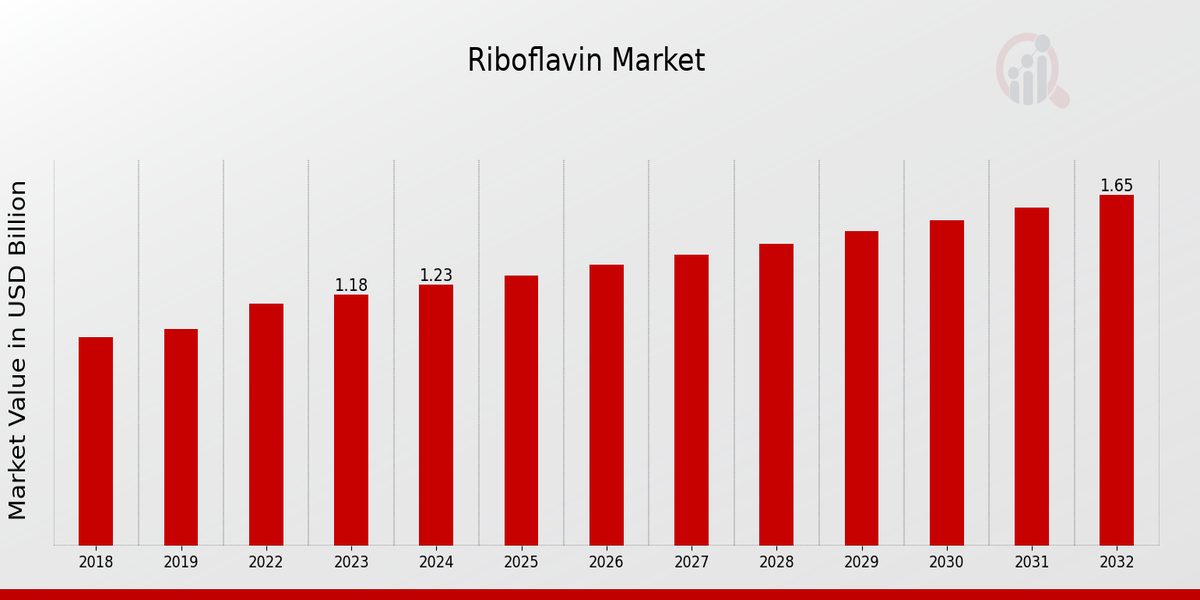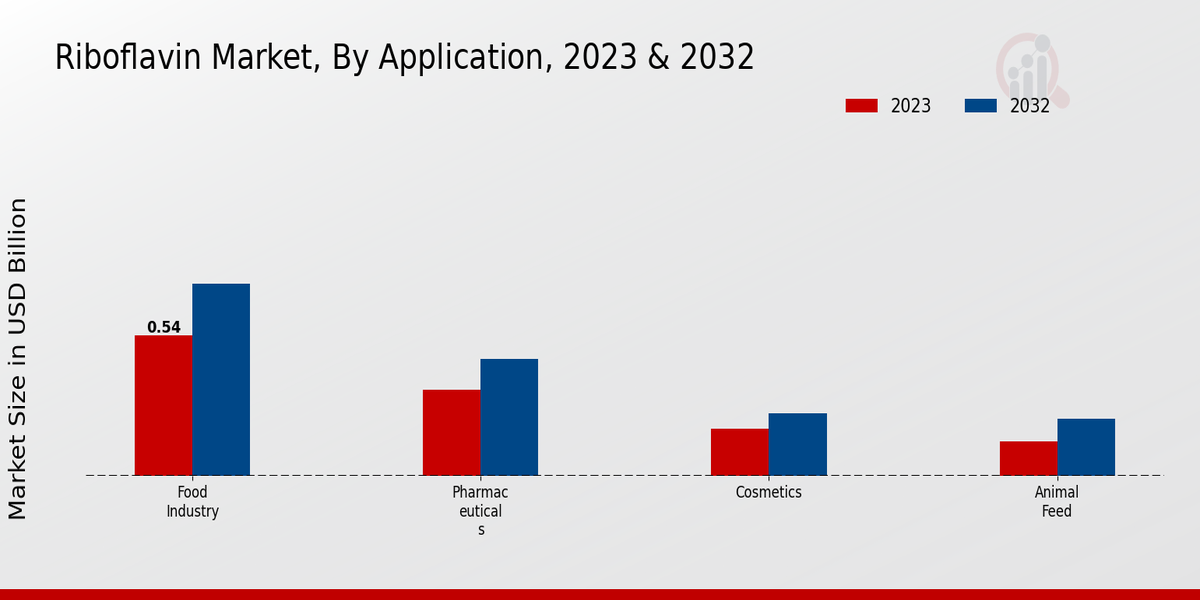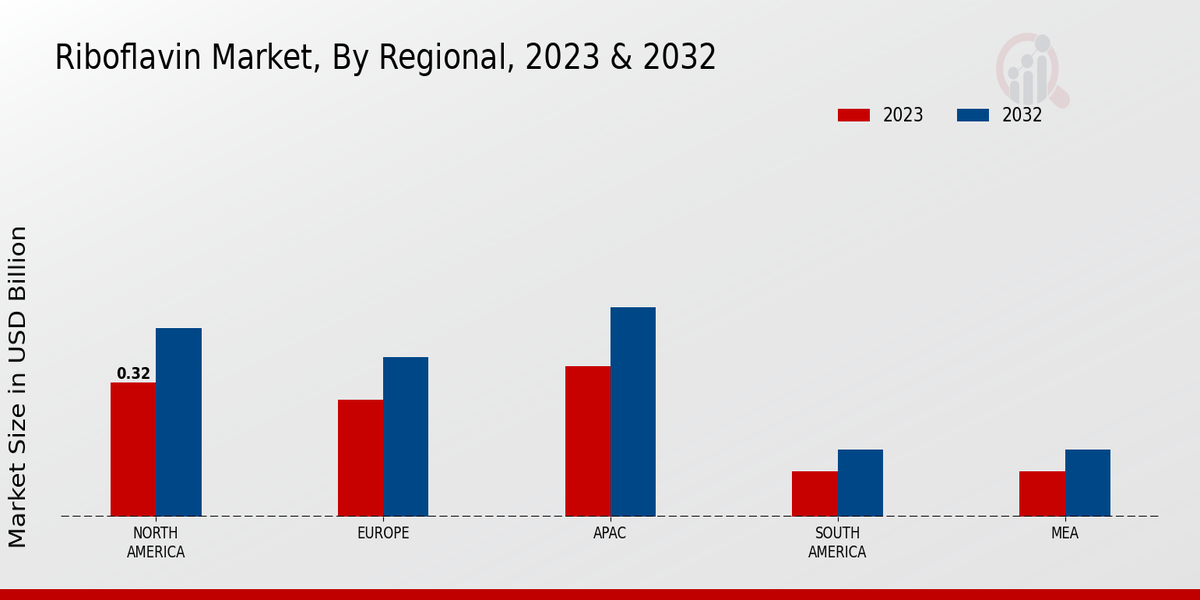Global Riboflavin Market Overview
Riboflavin Market Size was estimated at 1.14 (USD Billion) in 2022. The Riboflavin Industry is expected to grow from 1.18(USD Billion) in 2023 to 1.65 (USD Billion) by 2032. The Riboflavin Market CAGR (growth rate) is expected to be around 3.77% during the forecast period (2024 - 2032).

Source Primary Research, Secondary Research, MRFR Database and Analyst Review
Key Riboflavin Market Trends Highlighted
The riboflavin market has been driven by an increasing demand for dietary supplements and functional foods, as consumers become more health-conscious and aware of the importance of vitamins in their diet. The growing prevalence of deficiencies in essential nutrients has further propelled the demand for riboflavin, commonly known as Vitamin B2, which plays a crucial role in energy production and cellular function. Additionally, the expanding animal feed industry has emerged as a significant market driver, as riboflavin is essential for maintaining the health and growth of livestock. This trend reflects the broader shift towards more sustainable agricultural practices, where nutrient-rich feed is prioritized.Various opportunities lie ahead in the riboflavin market, particularly as innovations in food processing and formulation take center stage. There is potential for product development that caters to various demographics, such as vegan consumers, as riboflavin sourced from natural ingredients gains popularity. Companies can also explore the enhancement of riboflavin's delivery forms, appealing to consumers seeking convenience and efficacy in supplements. The increasing popularity of e-commerce channels presents further opportunities for market expansion, allowing companies to reach a wider audience seamlessly. In recent times, there has been a notable trend towards clean-label products, causing manufacturers to rethink their sourcing and production practices.Consumers are increasingly looking for transparency regarding the ingredients in their food and supplements, fueling a demand for natural and sustainably sourced riboflavin. The emphasis on health and wellness, tied to the growing rate of chronic diseases, has also pushed for more fortified products that contribute positively to overall nutrition. As these trends continue to evolve, the riboflavin market is poised for significant transformation, aligning with consumer priorities and health standards.
Riboflavin Market Drivers
Rising Demand for Nutritional Supplements
The demand for nutritional supplements is driving the growth of the Riboflavin Market Industry significantly. As consumers become increasingly health-conscious, there is a rising trend towards preventive healthcare and wellness. This has led to an increased popularity of vitamins and dietary supplements, particularly those that contain essential nutrients like riboflavin. The awareness about the health benefits associated with riboflavin, such as its role in energy production and metabolism, has spurred its incorporation into supplements.Furthermore, the rising cases of dietary deficiencies related to modern eating habits have made riboflavin supplementation essential for many individuals. The market for fortifying food and beverage products with vitamins and minerals has also expanded, with manufacturers seeking riboflavin to enhance the nutritional profile of their offerings, catering to consumer preferences for fortified foods. Moreover, the evolving lifestyle and dietary choices, especially in regions witnessing urbanization and changing dietary patterns, are expected to sustain demand for riboflavin.These trends indicate a strong trajectory for the Riboflavin Market Industry, fostering innovations in product formulations and marketing strategies that articulate the significance of riboflavin in daily health. As the focus shifts towards holistic well-being, riboflavin is poised for sustained growth through its application in various sectors, including supplements, functional foods, and beverages.
Growth in Animal Feed Industry
The growth of the animal feed industry is another crucial driver for the Riboflavin Market Industry. With the rising population and a concurrent increase in protein consumption, there has been a significant upsurge in the production and consumption of animal-derived products. Riboflavin plays an essential role in ensuring the health and productivity of livestock. It is vital for the growth and feed efficiency of animals, enhancing their overall health while maximizing production yields.As more livestock producers seek to improve the nutritional quality of their feed, the demand for riboflavin in animal nutrition continues to gain momentum. This is particularly evident in regions with a booming livestock sector, where the focus on animal welfare and productivity is becoming increasingly important. The increased adoption of riboflavin supplements in poultry, swine, and ruminant diets to prevent riboflavin deficiency has further augmented this market segment.
Increasing Awareness About Health Benefits of Vitamins
The growing awareness about the health benefits of vitamins such as riboflavin is stimulating the demand for healthy dietary choices among consumers. As health awareness grows globally, more individuals are focusing on balanced diets that fulfill their nutritional requirements. This has led to an increased intake of vitamins and minerals necessary for maintaining overall health. The Riboflavin Market Industry is benefiting as consumers seek riboflavin-rich food products and supplements that contribute to energy production, metabolism, and overall vitality.This consumer-driven trend promotes the development and marketing of innovative riboflavin-enriched products in various food and beverage sectors, enhancing the market's growth potential.
Riboflavin Market Segment Insights
Riboflavin Market Application Insights
The Riboflavin Market shows a robust structure within its Application segment, highlighting its versatile utilization across various industries. In 2023, the market is valued at approximately 1.18 USD Billion, with a notable emphasis on the Food Industry, Pharmaceuticals, Cosmetics, and Animal Feed. Among these, the Food Industry holds the majority share, accounting for about 0.54 USD Billion, which is expected to grow to 0.74 USD Billion by 2032. This growth reflects the rising consumer demand for fortified foods and nutritional supplements, positioning the Food Industry as a significant contributor to the overall market dynamic.
Pharmaceuticals also represent a critical area for Riboflavin applications, with a valuation of 0.33 USD Billion in 2023, projected to reach 0.45 USD Billion by 2032. The use of Riboflavin in drug formulations and as an essential dietary supplement supports its importance in the healthcare sector. The Cosmetics industry, while smaller, shows potential with a market valuation of 0.18 USD Billion in 2023, potentially increasing to 0.24 USD Billion by 2032. Riboflavin is recognized for its benefits in skin health and enhancement, making it a key ingredient in various cosmetic products. Lastly, the Animal Feed application, valued at 0.13 USD Billion in 2023 and expected to rise to 0.22 USD Billion by 2032, also reflects a growing emphasis on animal nutrition and health. The rising demand for high-quality livestock and poultry products significantly drives this segment's growth.
Overall, the application segmentation of the Riboflavin Market illustrates dynamic growth trajectories across different sectors, with the Food Industry leading in both current valuation and projected growth, while Pharmaceuticals and Cosmetics also play increasingly significant roles. This segmentation highlights how the Riboflavin Market adapts to varying consumer needs and trends, reflecting both challenges and opportunities for sustained industry development in the years to come as it caters to diverse applications across multiple sectors.

Source Primary Research, Secondary Research, MRFR Database and Analyst Review
Riboflavin Market Form Insights
The Riboflavin Market revenue in 2023 stands at approximately 1.18 billion USD, showcasing a steady demand for riboflavin across various applications. Within the market segmentation based on form, the powder, liquid, and tablet forms of riboflavin play essential roles in meeting consumer needs. The powdered form is often favored due to its ease of incorporation into dietary supplements and food products, catering to health-conscious consumers seeking nutritional enrichment. The liquid form, though less common, remains valuable in pharmaceutical applications, providing an alternative for those who may have difficulty swallowing tablets.Tablets maintain significant market presence due to their convenience and dosage accuracy, appealing to a broad demographic. As trends towards health and wellness continue to rise, the growing consumption of fortified foods and dietary supplements supports the overall market growth, while challenges such as regulatory hurdles and cost pressures on raw materials may affect future dynamics. Nonetheless, opportunities abound in emerging economies where increased awareness of nutritional benefits fuels demand for riboflavin in various forms. The Riboflavin Market statistics indicate a potential expansion, with a projected valuation of 1.65 billion USD by 2032, driven by rising health trends and diverse consumer preferences.
Riboflavin Market End Use Insights
The Riboflavin Market revenue reflects a growing interest in various end-use applications, leading to an expected value of 1.18 billion USD in 2023. The market displays a wide segmentation that includes Dietary Supplements, Fortified Foods, and Nutraceuticals, with each category contributing to a healthy growth trend. Dietary Supplements, in particular, serve a significant role in health and wellness, offering essential nutrients which consumers increasingly prioritize in their daily regimes. Fortified Foods also play a crucial role in combating nutritional deficiencies, making them a major segment within the market, as producers aim to enhance the nutritional profile of a wide range of food products.Additionally, Nutraceuticals represent a rapidly growing sector that integrates functional ingredients into everyday products, signifying a shift towards preventative healthcare. The combined influence of health-conscious consumers and increasing awareness of the benefits of riboflavin positions these segments for sustained growth, reflecting positive Riboflavin Market Statistics and trends in the overall Riboflavin Market industry. The anticipated market growth is supported by diverse opportunities presented through healthy living movements and evolving consumer preferences for fortified nutritional solutions.
Riboflavin Market Source Insights
The Riboflavin Market, valued at 1.18 billion USD in 2023, exhibits a diverse Source segmentation, primarily consisting of Natural and Synthetic categories. Natural sources of riboflavin, derived from food items like eggs, nuts, and green vegetables, capture significant attention due to increasing consumer preference for organic and naturally sourced dietary supplements. This trend is driven by growing health awareness and a shift towards clean-label products. On the other hand, the Synthetic category offers advantages in cost-effectiveness and batch consistency, which are crucial for large-scale production.As the market evolves, both segments are expected to contribute to overall market growth. The Riboflavin Market statistics suggest that the balance between natural and synthetic sources reflects broader trends in dietary choices and manufacturing efficiencies, highlighting opportunities for innovation. The demand for riboflavin in various applications, such as food beverage, pharmaceuticals, and animal feed, continues to rise, indicating robust growth potential within these segments.
Riboflavin Market Regional Insights
The Riboflavin Market is witnessing notable activity across its regional segments. In 2023, North America occupies the market with a valuation of 0.32 USD Billion, expected to rise to 0.45 USD Billion by 2032, showcasing its prominent holding in Riboflavin consumption due to strong demand in the food and beverage industry. Europe follows with a valuation of 0.28 USD Billion in 2023, growing to 0.38 USD Billion, driven by increasing awareness regarding nutritional supplements. The Asia-Pacific region holds the dominant position with a value of 0.36 USD Billion in 2023 and is anticipated to reach 0.5 USD Billion by 2032, supported by its expanding pharmaceutical and dietary supplement sectors.South America and the Middle East Africa (MEA) both stand at 0.11 USD Billion in 2023, potentially growing to 0.16 USD Billion by 2032. While these regions currently represent the smallest share of the Riboflavin Market revenue, their emerging markets offer significant growth opportunities driven by rising health consciousness and dietary needs. Thus, the regional segmentation suggests a balanced growth trajectory influenced by both established and developing markets, presenting various trends and opportunities within the Riboflavin Market industry.

Source Primary Research, Secondary Research, MRFR Database and Analyst Review
Riboflavin Market Key Players and Competitive Insights
The Riboflavin Market represents a dynamic and competitive space characterized by various players who are continually innovating to capture market share. Riboflavin, also known as Vitamin B2, plays a critical role in human nutrition and is widely utilized in food, feed, and pharmaceutical industries. The market's competitive landscape is influenced by factors such as production capabilities, pricing strategies, technological advancements, and shifts in consumer preferences toward dietary supplements and fortified products. Companies strive to establish strong brand loyalty while focusing on expanding their market presence in emerging economies, where the demand for nutritional products is on the rise. The competition is further intensified by the growing emphasis on sustainable production methods, strict regulations in food safety, and the increasing importance of product quality.Boda Biotech stands out within the Riboflavin Market due to its commitment to high-quality production and innovative approaches. The company has developed a strong market presence by focusing on the efficient and eco-friendly production of riboflavin, which not only meets industry standards but also caters to the increasing consumer demand for sustainable products. Boda Biotech's strengths lie in its research and development capabilities, allowing for continuous improvement in product formulation and production techniques. This focus on innovation has enabled the company to differentiate itself from competitors, making its products more attractive to various market segments, including food and dietary supplement manufacturers. Additionally, Boda Biotech’s robust distribution network enhances its reach and allows it to respond quickly to market fluctuations and customer needs, further solidifying its position in the riboflavin sector.BASF is another key player in the Riboflavin Market, recognized for its substantial scale and integrated operations. With a diversified product portfolio, BASF leverages its extensive research and development capabilities to deliver high-quality riboflavin solutions tailored to the specific requirements of its clients. Known for its strong emphasis on sustainability and innovation, BASF has implemented advanced technologies in its manufacturing processes, allowing for cost-efficient production while minimizing environmental impact. The company’s presence facilitates its ability to serve a wide range of industries, from food to animal nutrition and pharmaceuticals, establishing BASF as a reliable partner. The backing of a well-established brand further enhances BASF's competitive edge in the market, as customers trust its commitment to quality and safety, ensuring a strong foothold in the riboflavin segment.
Key Companies in the Riboflavin Market Include
- Boda Biotech
- BASF
- DSM
- Jiangxi East Hope Group
- Liman Chemical
- Zhejiang Shenghua Biok Biology
- Huanggang Taitian Bioengineering
- Ginkgo BioWorks
- Nutraceutical International
- Zhuhai Qianjing Bioengineering
- Jiaozuo Yitong Biological Technology
- Luhua Biomaterials
- RIBOFLAVIN GMBH
- Santo Agro
- Shandong Wonderful Industrial Group
Riboflavin Market Industry Developments
Recent developments in the Riboflavin Market indicate an upward trajectory in market valuation, driven by increasing demand for dietary supplements and food fortification. Companies such as Boda Biotech, BASF, and DSM are expanding their production capacities to capitalize on this trend. Additionally, Jiangxi East Hope Group and Liman Chemical have focused on enhancing sustainability in their manufacturing processes, aligning with environmental standards. Current affairs also highlight strategic partnerships and collaborations among key players to innovate riboflavin production techniques, improving both yield and quality. However, no recent mergers or acquisitions have been prominently reported among the specified companies like Ginkgo BioWorks, Nutraceutical International, and others, indicating a period of organic growth rather than consolidation. Companies such as Huanggang Taitian Bioengineering and Zhejiang Shenghua Biok Biology are focusing on expanding their market share through increased RD activities, responding to the diverse needs of the nutraceutical sector. This evolving landscape reflects a dynamic and competitive environment where established players are continuously adapting to market demands and regulatory challenges in the riboflavin industry.
Riboflavin Market Segmentation Insights
- Riboflavin Market Application Outlook
- Food Industry
- Pharmaceuticals
- Cosmetics
- Animal Feed
- Riboflavin Market Form Outlook
- Riboflavin Market End Use Outlook
- Dietary Supplements
- Fortified Foods
- Nutraceuticals
- Riboflavin Market Source Outlook
- Riboflavin Market Regional Outlook
- North America
- Europe
- South America
- Asia Pacific
- Middle East and Africa
| Report Attribute/Metric |
Details |
| Market Size 2022 |
1.14(USD Billion) |
| Market Size 2023 |
1.18(USD Billion) |
| Market Size 2032 |
1.65(USD Billion) |
| Compound Annual Growth Rate (CAGR) |
3.77% (2024 - 2032) |
| Report Coverage |
Revenue Forecast, Competitive Landscape, Growth Factors, and Trends |
| Base Year |
2023 |
| Market Forecast Period |
2024 - 2032 |
| Historical Data |
2019 - 2023 |
| Market Forecast Units |
USD Billion |
| Key Companies Profiled |
Boda Biotech, BASF, DSM, Jiangxi East Hope Group, Liman Chemical, Zhejiang Shenghua Biok Biology, Huanggang Taitian Bioengineering, Ginkgo BioWorks, Nutraceutical International, Zhuhai Qianjing Bioengineering, Jiaozuo Yitong Biological Technology, Luhua Biomaterials, RIBOFLAVIN GMBH, Santo Agro, Shandong Wonderful Industrial Group |
| Segments Covered |
Application, Form, End Use, Source, Regional |
| Key Market Opportunities |
Growing demand in food industry, Expanding animal nutrition sector, Increasing health consciousness among consumers, Rising demand in cosmetics sector, Advancements in biotechnology applications. |
| Key Market Dynamics |
Increasing health awareness, Growing demand for natural additives, Expanding food and beverage industry, Rising supplement consumption |
| Countries Covered |
North America, Europe, APAC, South America, MEA |
Frequently Asked Questions (FAQ) :
The Riboflavin Market is expected to be valued at 1.65 billion USD in 2032.
The expected CAGR for the Riboflavin Market from 2024 to 2032 is 3.77%.
The Food Industry segment is projected to hold the largest market share valued at 0.74 billion USD in 2032.
In 2023, the Riboflavin Market in North America is valued at 0.32 billion USD.
The Pharmaceuticals segment is projected to be valued at 0.45 billion USD in 2032.
Key players in the Riboflavin Market include Boda Biotech, BASF, and DSM.
The Cosmetics segment is valued at 0.18 billion USD in 2023.
The Animal Feed segment is expected to reach a value of 0.22 billion USD in 2032.
In 2023, the Riboflavin Market in Europe is valued at 0.28 billion USD.
The MEA region is expected to be valued at 0.16 billion USD in 2032.

















